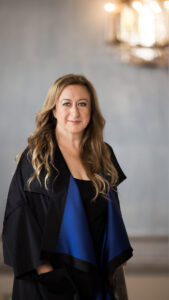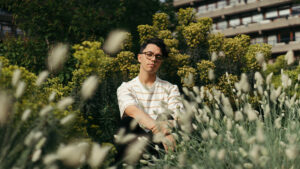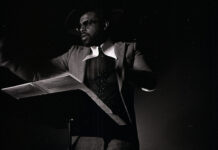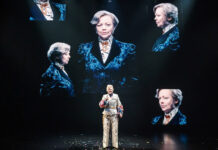“It is how the music works. There’s the tension, the atmosphere, the structure. You feel it in the intensity of the audience’s focus and concentration. It’s not something I have to consciously think about. It’s just part of the experience.”

That’s conductor Simone Young talking about her concept of music as vibrating air. As someone who has been conducting for 35 years, Young immediately adds that “I’m very blessed in that I generally do repertoire where that’s a given.”
She’s just completed concerts on the East Coast that included works by Benjamin Britten, Arvo Pärt and Dmitri Shostakovich. This week she’s on the West Coast with performances on Friday and Sunday with the Los Angeles Philharmonic of works by Johannes Brahms, Connor D’Netto and Erich Wolfgang Korngold. Then she’s off to the Bay area to lead the San Francisco Symphony in performances of works by Edward Elgar and Pyotr Ilyich Tchaikovsky from December 2nd to the 4th.
It’s a large and diverse repertoire to cover in just a few weeks, but points to a life spent studying and conducting this music.
“My interests are fairly broad in music,” she said during a recent phone interview. “But I guess a heavy part of my repertoire is the German romantic repertoire starting more or less with Beethoven and going right through to the second Viennese school and Hindemith and onwards to Henze. But also I’m very focused on 20th century music and now 21st century music as we find ourselves already two decades into the 21st century. There’s a lot of great music being written that needs to be heard.”
Part of that new music is the US premiere of Uncertain Planning by composer D’Netto. Young conducted the world premiere of the work in Sydney earlier this year.

“I think it’s very interesting to find such an original voice in a composer who is so young, in his mid-20s,” she says of D’Netto. “He is an extremely skilled composer. It’s very elegantly crafted. Despite the almost formality of its structure – an allegro opening, a slower more lyrical middle section and then a fast and exciting third section – he finds new things to say in each of those. I love the title. I think there is humor and also some self-examination in that.”
D’Netto wrote the work during the pandemic. Of the composition Young says, “I think that’s kind of reflective of how fragmented [we’ve been], but also the longing for the music that we have all felt in these past 18 months.”
Like many people who make their living in the performing arts, Young faced cancellation after cancellation, often with little advance notice. She says of this time that “it came rather as a surprise to me and that I felt that the ground had been pulled out from underneath my feet.”
Over three decades of experience left the maestro in better shape that many of her colleagues. Given what she’s heard from them she has real fears about the long-term impact the pandemic will have on the arts.
“There are a lot of people in Europe who have given up being professional musicians because it’s just been too difficult,” she reveals. “I know musicians in the UK who’ve sold their instruments to make ends meet. I fear we are losing a generation of talented students and recent graduates because there’s been nothing for them to go into. I think the consequences of this will be felt for a very long time. And that’s just in our industry. That’s before you get into talking about what it’s done to the nation’s economies and to people’s health and politicizing and dividing nations further. It’s just been truly ghastly.”
She is, of course, keenly aware of how lucky she is in spite of recent challenges.
“To be performing such an extraordinary range of music is both a great joy and it’s a challenge, but most of all it’s a tremendous privilege.” Like the Brahms Fourth Symphony which she’ll be conducting in Los Angeles.
“It’s one of my favorite symphonies. I think it’s an extraordinarily forward-looking work. It shows us the way towards really the the first half of the 20th century where composers took very formal structures and then created something new. I think it’s a truly powerful and emotive work that is beautifully constructed.”
Her passion for Brahms aligns with something the composer said. “The idea comes to me from outside of me and it’s like a gift. I then take the idea and make it my own. That is where the skill lies.” Young believes the idea springs from the work of composers like Brahms followed by intense work she does.
“The idea comes off the written page. I spend hours and hours studying scores, but also studying manuscripts, studying references. I want to get as much information about the thought process and the work process. Working in the mind of the composer whether it’s a new work or a work that’s 300 years old. I want to find out what is driving them to write this music. Then, as Brahms says, the skill comes in taking that and communicating it to your audience through your work with the orchestra. I think you have there defined what a conductor does.”
Young admits there’s also something else a conductor does.
“Every conductor you’ll talk to will have a corner in a symphony where I wish I could ask Tchaikovsky what exactly he was thinking there. Or I wish I could ask Brahms why he used that particular syncopation there. Or whether he really means the horns to go so strongly against the violins. Or is that a notational shorthand. Everyone has questions and there are no clear answers to that. You can only base your own decision on profound research and then instinct informed by experience. I’m in a profession where, having just turned 60 this year, I really feel like I’m only just coming into my own now.”
Photos of Simone Young by Sandra Steh (Courtesy Arsis Artist Management)










